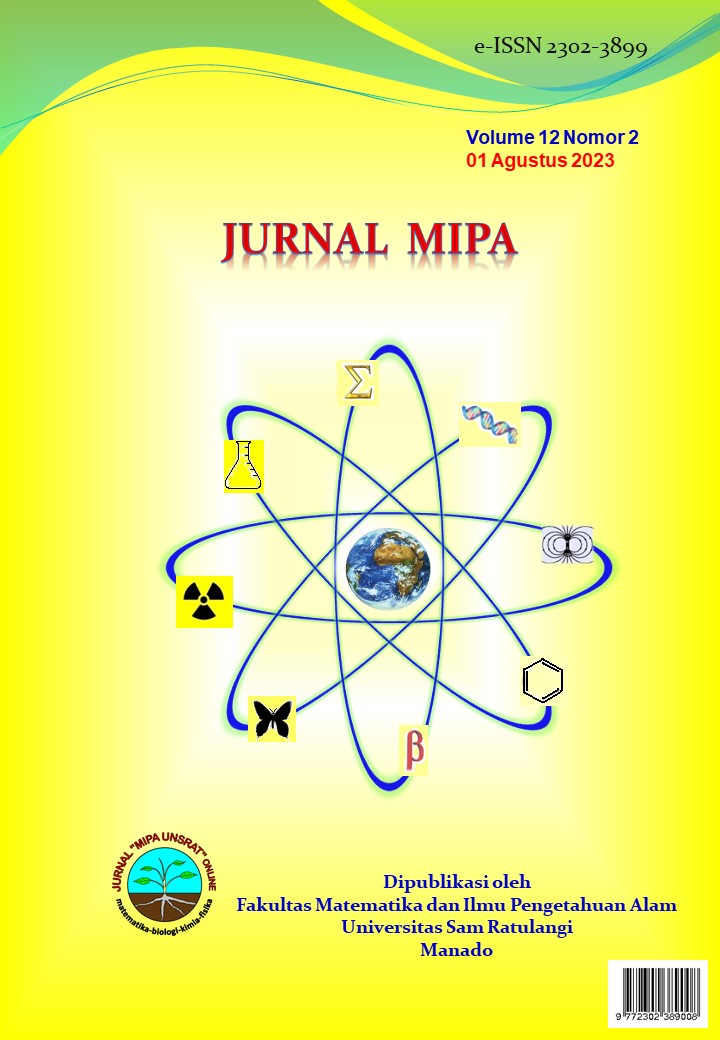Aplikasi Metarhizium anisopliae Dan Azadirachta indica A. Juss Untuk Mengendalikan Nephotettix virescens D. Sebagai Serangga Vektor Penyakit Tungro Pada Tanaman Padi
DOI:
https://doi.org/10.35799/jm.v12i2.49072Abstract
Wereng hijau (Nephotettix sp.) diketahui merupakan serangga vektor penyakit tungro pada tanaman padi. Pengendalian hayati dengan memanfaatkan jamur entomopatogen berpotensi untuk dikembangkan, contohnya jamur entomopatogen M. anisopliae. Pengendalian lain yang juga dapat dilakukan yaitu dengan penggunaan pestisida nabati, seperti esktrak daun mimba. Penelitian ini bertujuan untuk menganalisis pengaruh aplikasi jamur M. anisopliae sebagai jamur entomopatogen dan aplikasi ekstrak daun mimba terhadap mortalitas N. virescens. Hasil pengamatan dari aplikasi jamur entomopatogen dan ekstrak daun mimba pada beberapa taraf konsentrasi memiliki efek yang mematikan terhadap serangga N. virescens. Mortalitas tertinggi dari aplikasi jamur entomopatogen M. anisopliae berada pada kerapatan spora 108 per ml (P3) dan 109 per ml (P4) yaitu 100 %. Mortalitas tertinggi dari aplikasi ekstrak daun mimba berada pada perlakuan 150 gr (P3) dan 200 gr (P4) yaitu mencapai 100 %. Serangga N. virescens setelah diaplikasikan dengan jamur entomopatogen M. anisopliae menunjukkan perilaku dengan gerakan melambat kemudian mati. Perilaku serangga saat aplikasi ekstrak daun mimba menunjukkan penurunan daya makan hingga perkembangan yang melambat kemudian serangga mati. Berdasarkan penelitian yang telah dilakukan, dapat dilihat bahwa aplikasi jamur entomopatogen M. anisopliae dan aplikasi pestisida nabati ekstrak daun A. indica, keduanya dapat menyebabkan mortalitas pada serangga N. virescens
Green leafhoppers (Nephotettix sp.) are known to be vectors of tungro disease in rice plants. Biological control by utilizing entomopathogenic fungi has the potential to be developed, for example the entomopathogenic fungus M. anisopliae. Another control that can also be done is by using vegetable pesticides, such as neem leaf extract. This study aims to analyze the effect of the application of M. anisopliae fungus as an entomopathogenic fungus and the application of neem leaf extract on the mortality of N. virescens. The results showed that the application of entomopathogenic fungi and neem leaf extract at several concentration levels had a lethal effect on the insect N. virescens. The highest mortality from the application of the entomopathogenic fungus M. anisopliae was at a spore density of 108 per ml (P3) and 109 per ml (P4), namely 100%. The highest mortality from the application of neem leaf extract was in the treatment of 150 gr (P3) and 200 gr (P4), which reached 100%. After being applied with the entomopathogenic fungus M. anisopliae, the insect N. virescens showed behavior with slowed movements and then died. Insect behavior when the application of neem leaf extract showed a decrease in eating power until development slowed down and then the insects died. Based on the research that has been done, it can be seen that the application of the entomopathogenic fungus M. anisopliae and the application of botanical pesticides of A. indica leaf extract, both can cause mortality in the insect N. virescens.
Downloads
Published
Issue
Section
License
Copyright (c) 2023 Yukiko Susandi, Christina Leta Salakia, Jackson Fraky Watung

This work is licensed under a Creative Commons Attribution-NonCommercial 4.0 International License.






